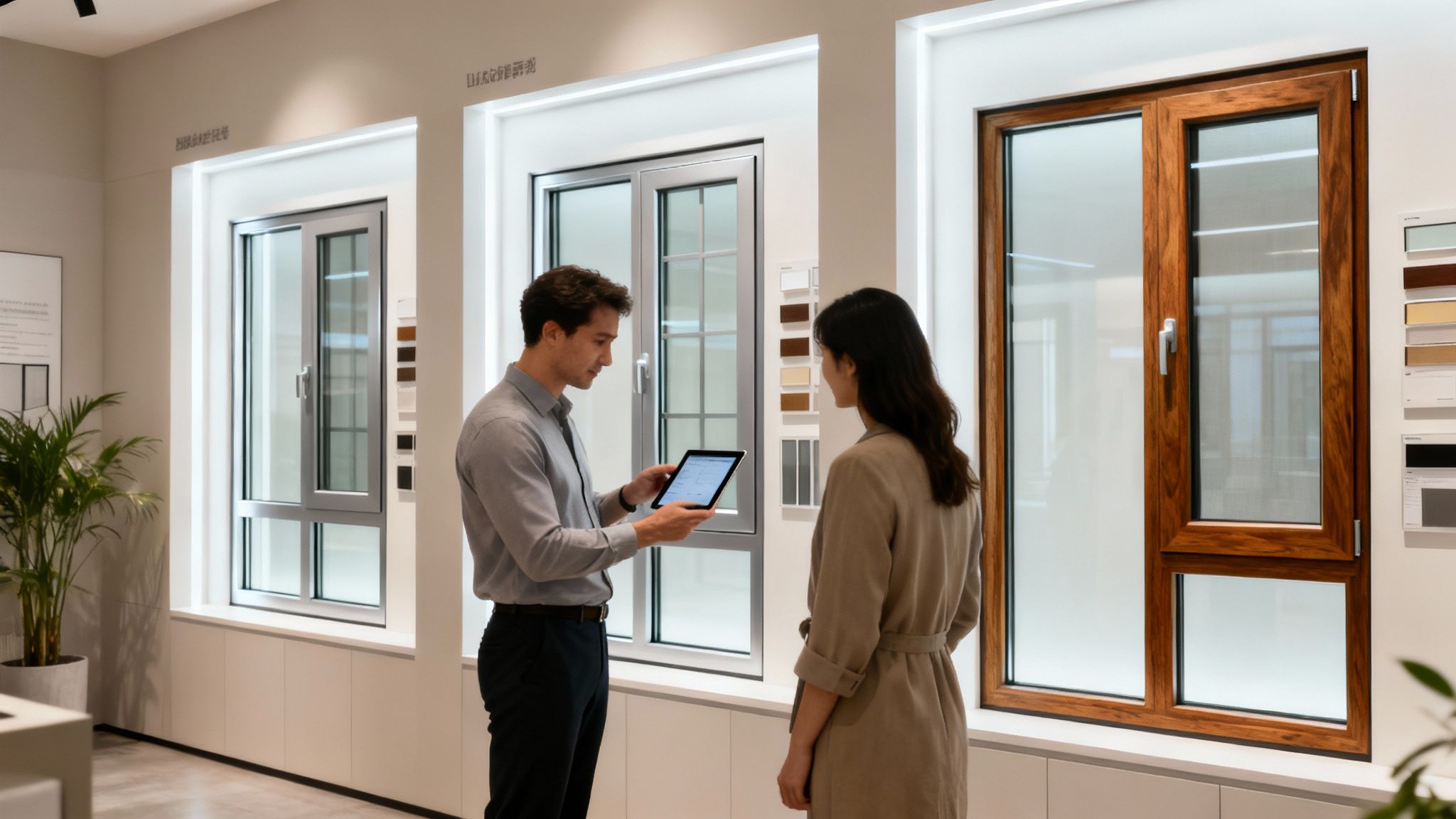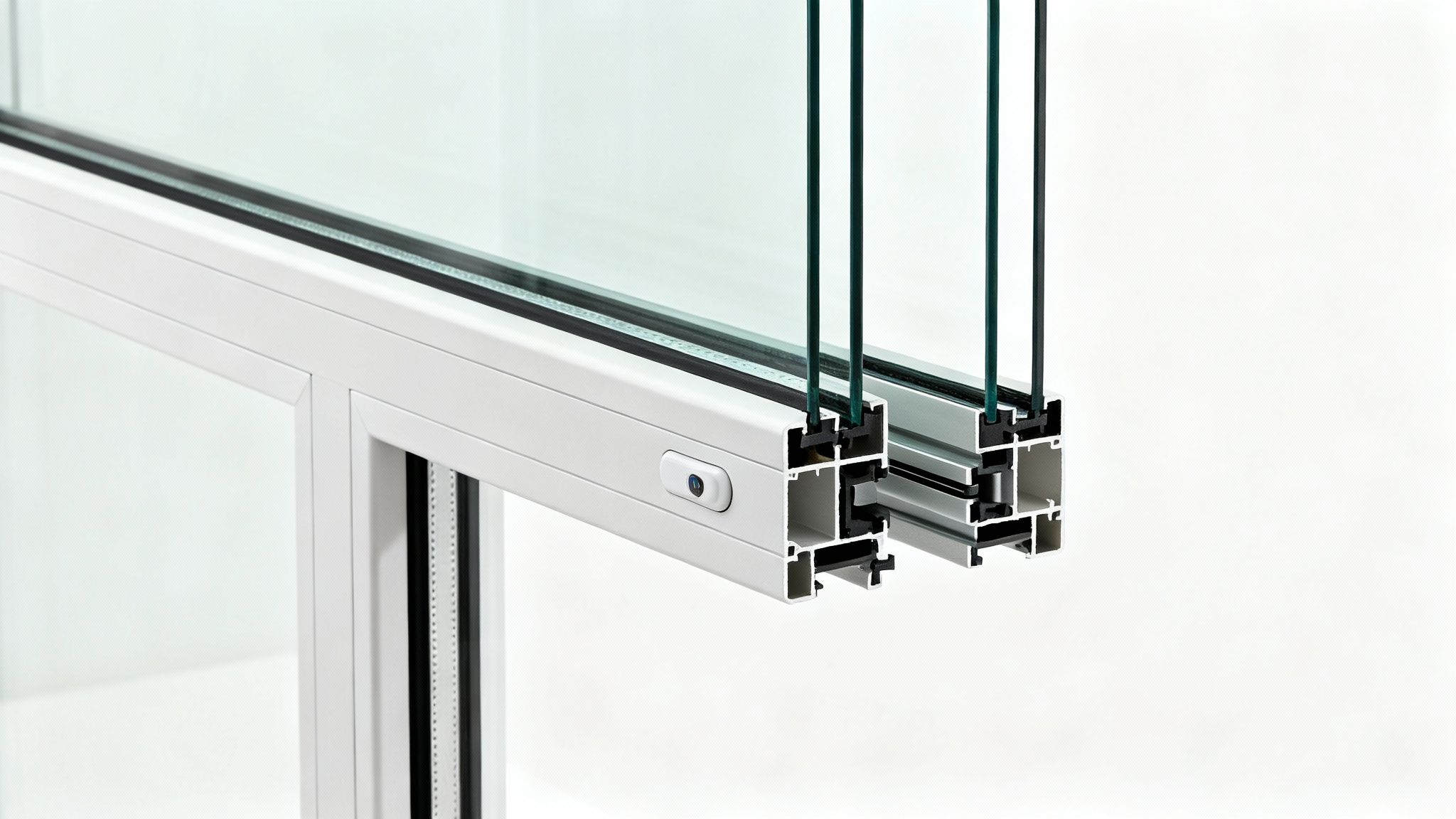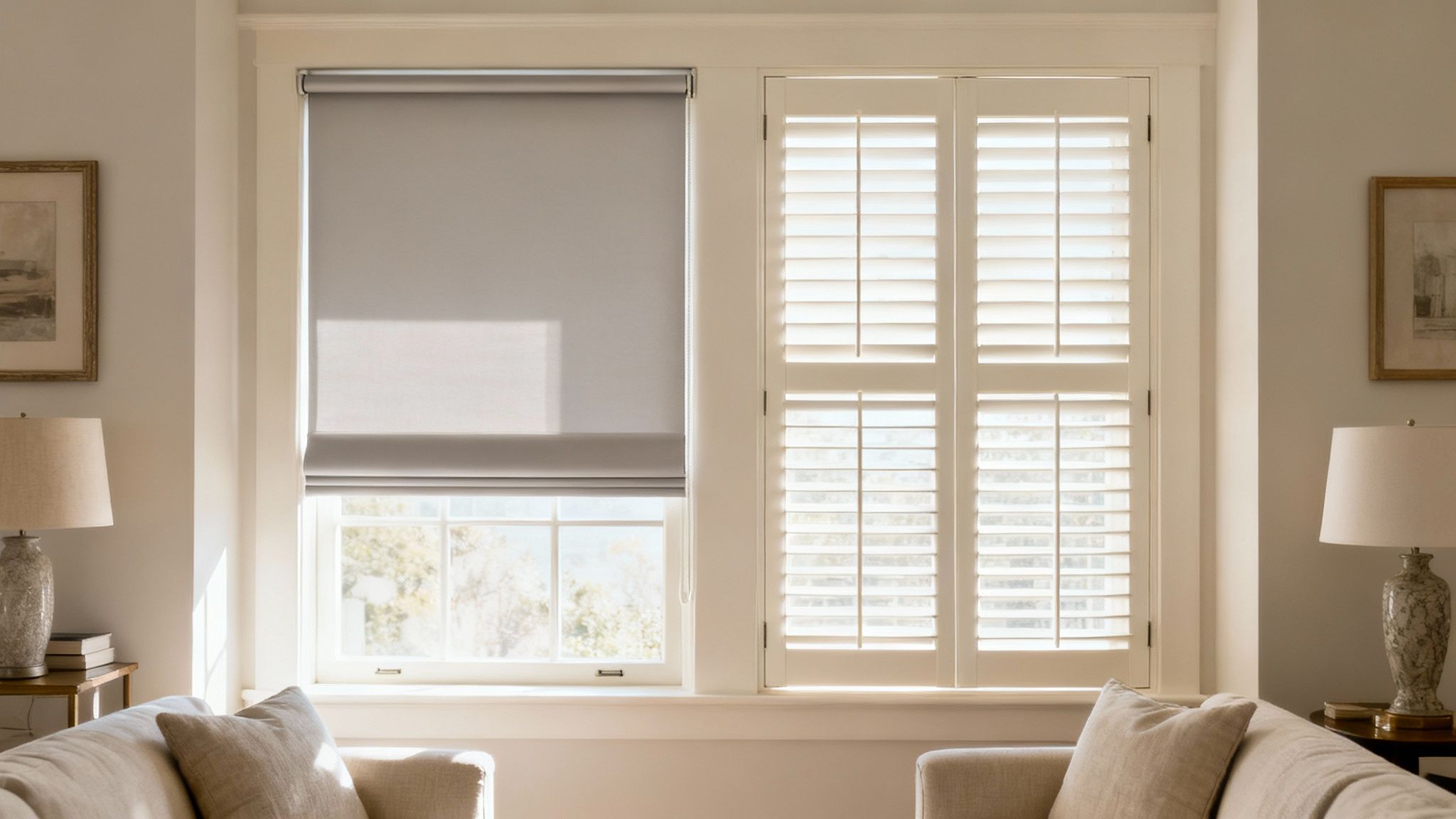Australia
When it comes to buying new windows, you’re generally looking at two main paths: heading to a large national manufacturer with a massive showroom, or working with a smaller, local installer who offers a more personalised touch. Each route has its own pros and cons, catering to different priorities, from huge product selections and solid warranties to custom jobs and hands-on support.
Your Quick Guide to Sourcing New Windows in Australia
Figuring out the window market can feel a bit like choosing between a giant department store and a local boutique. Both have their place, and the right one for you really just depends on what your project needs. Getting a handle on these differences is the first step to making a smart, confident decision for your home.
The Australian window and door market is a big deal, valued at AUD 5.73 billion and set to grow even more thanks to new builds and a major focus on energy efficiency. All this growth is great news for you—it means more choice than ever before. For a bit of an international perspective on window selection, this detailed homeowner's guide to choosing the best windows offers some great tips, even though it’s geared towards a different climate.
Finding the Right Supplier for You
What matters most to you? Is it the budget? The ability to get something custom-made? Or just seeing a huge variety of options? Your main priority will point you in the right direction.
If you’re focused on keeping costs down and want a more hands-on service, a local installer is usually your best bet. On the flip side, if you really need to see and touch a wide range of styles and materials in person, you just can’t beat a national supplier’s showroom.
This decision tree infographic gives you a quick visual on which path makes the most sense based on what you’re prioritising.

As the graphic shows, if a massive selection is your top concern, you’ll naturally lean towards national suppliers. But if the budget is the main driver, local installers or even a DIY approach will be more up your alley.
Working with Major National Window Suppliers
When you’re trying to figure out where to buy windows, the big national suppliers often feel like the most obvious starting point. These are the department stores of the window industry – large-scale manufacturers and retailers known for their huge selections, reliable quality, and the reassurance of a household name.
The journey usually begins in one of their showrooms. This is a massive step up from flipping through a catalogue; it’s a chance to get hands-on with full-size window displays. You can physically feel the difference between an aluminium and a uPVC frame, test how smoothly a sliding door operates, and see various glazing options side-by-side. That tactile experience is priceless for truly understanding what you're investing your money in.
The Showroom and Quoting Process
Once you’re in the showroom, you’ll usually be guided by product specialists who can translate all the technical jargon. They’re there to demystify terms like U-values and solar heat gain coefficients, helping you pick a window that actually makes sense for your home’s climate and energy goals. This is the perfect time to ask all your detailed questions and explore the customisation options, from frame colours to handle finishes.
After you’ve got a good idea of what you want, the quoting process kicks off. The supplier will almost always schedule an on-site measurement to make sure every dimension is spot-on before they draw up a formal quote.
It is absolutely critical to insist on an itemised quote. Make sure it clearly separates the cost of the window units from the installation labour. This transparency is the only way to compare different offers accurately and see exactly where your money is going, avoiding nasty surprises later.
The final stage is confirming your order and getting a manufacturing lead time. Since most of these windows are made-to-order, you should expect a wait of several weeks for production and delivery. The upside, however, is getting a product built specifically for your home, complete with a comprehensive manufacturer’s warranty for long-term peace of mind.
Choosing Energy Efficient and Smart Windows
These days, modern windows are so much more than just panes of glass in a wall; they're sophisticated, high-performance components that are absolutely crucial to how your home feels and functions. A good way to think of them is like a high-tech jacket for your house. A cheap jacket might keep some wind off, but a proper performance one uses advanced materials to keep you warm, dry, and genuinely comfortable. In the same way, high-performance windows are designed to regulate the temperature and comfort inside your home.
This performance comes from a few key features all working together. The most well-known is double glazing, which is simply two panes of glass separated by a sealed gap filled with air or an inert gas. That small separation creates a powerful insulating barrier that dramatically cuts down on heat transfer, keeping your home warmer in winter and much cooler in summer. To really get a handle on the technology, exploring the key double glazed windows benefits can show you just how much of a difference the right options can make.
Beyond the Basics of Efficiency
To really boost this effect, many modern windows also feature Low-E (low-emissivity) coatings. This is a microscopically thin, invisible metallic layer that reflects heat, helping to keep warmth inside during winter and blocking the sun’s heat from getting in during summer. On top of that, high-quality frames made from materials like uPVC or thermally broken aluminium are essential, as they prevent the frame itself from conducting heat—a common weak point in older window designs.

The market is clearly shifting towards these advanced solutions. Spurred on by growing environmental awareness and the very real desire to slash energy bills, it's estimated that around a quarter of all windows sold in Australia are now energy-efficient or smart. That proportion is only expected to climb as building codes get stricter.
The real magic of an energy-efficient window is its ability to lower your energy bills, year after year. While the initial investment might be higher, the long-term savings on heating and cooling often deliver a significant return, not to mention a far more comfortable home.
Finally, the whole concept of ‘smart’ windows is really starting to gain traction. This can mean anything from windows with integrated sensors that monitor air quality to motorised openers that can be automated to create natural ventilation. When you're talking to suppliers, make sure you ask them to explain the U-value and the Solar Heat Gain Coefficient (SHGC) of their products. These ratings give you a clear, standardised way to compare the thermal performance of different windows, ensuring you can make a truly informed choice.
Partnering with Local Retailers and Installers
While the big national suppliers offer sheer scale, the search for where to buy windows often leads right back to the incredible value you find with local, independent businesses. Working with a local installer is like hiring a neighbourhood expert who instinctively gets the challenges and styles unique to your area, from weathering coastal spray to respecting heritage building codes. This path swaps vast, impersonal showrooms for genuine, one-on-one service.

This direct relationship almost always translates into more flexibility for your project. If you’ve got an awkwardly shaped opening or a specific design in mind, a local craftsperson can usually offer more bespoke solutions than a mass-production factory can. On top of that, choosing a local business means your investment circulates right back into your community’s economy.
Vetting Your Local Window Supplier
Finding the right local partner does require a bit of homework to make sure you’re getting quality craftsmanship and reliable service. Before you sign anything, it’s vital to check a few key details to protect your home and your investment.
First, check their credentials. Any reputable installer should be fully licensed and carry public liability insurance. Don't just take their word for it; asking to see the actual documents will give you complete peace of mind.
Next, dig into their reputation. Look up online reviews on sites like Google or local trade directories, but don't stop there. Ask for references you can actually speak to. Hearing directly from past customers gives you unfiltered insight into their professionalism, timeliness, and the real-world quality of their finished work.
A great question to ask a potential installer is about their experience with homes just like yours. A company that mainly does modern new builds might not be the best fit for a delicate heritage renovation, and vice versa. Matching their experience to your project type is crucial for a smooth process.
Finally, get crystal clear on their after-sales support. A confident installer will always stand by their work with a straightforward warranty covering both the installation itself and the window products they supply. Knowing they’ll be around to sort out any issues gives you long-term confidence in your decision.
How Window Coverings Impact Your Decision
Thinking about which windows to buy is only half the battle. Your project isn't really finished until you've figured out the window coverings, and it’s a mistake to leave them as an afterthought.
The style of window you choose has a direct knock-on effect on your options for blinds, curtains, or shutters. A beautiful casement window that cranks outward, for instance, is a terrible match for a tight-fitting exterior shutter. Likewise, the sleek, minimal look of an internally mounted roller blind can be ruined by the handle on an awning window getting in the way.
Considering these two elements together from the very beginning prevents design clashes and expensive fixes down the track. It ensures your new windows and their dressings not only look great but work perfectly in tandem.
Sourcing Coverings Versus Windows
It’s worth remembering that the buying process for windows and their coverings are often completely different.
Window coverings are part of a huge Australian manufacturing industry, valued at around AUD 895 million. Unlike the supply-and-install model you’ll use for your windows, coverings are often bought as off-the-shelf retail products from home improvement stores or online. You can get a better sense of this market by exploring insights on Australia’s window covering industry.
This contrast is an important part of your planning. While you'll be working with specialised installers for the windows themselves, you might end up handling the coverings as a separate, much simpler purchase.
By thinking about both elements at once, you can align your budgets and timelines. For example, if you know you want heavy, thermal-lined curtains, you can ensure your window frames are installed to easily support the weight of a sturdy curtain rod. This forethought ensures both style and function are perfectly matched.
Common Questions About Buying New Windows
Thinking about replacing your windows naturally brings up a lot of questions. From figuring out costs to choosing the right materials, getting clear answers is the key to feeling confident in your decisions. We've pulled together some of the most common queries to help demystify the process.

This section is all about straightforward answers, giving you the essential info you need to move your project forward without a hitch.
What Is the Average Cost of Replacing a Window in Australia?
The cost of a new window here in Australia can vary wildly depending on its size, the frame material, and the type of glass you choose. For example, a small, standard aluminium window with single glazing might only set you back a few hundred dollars. On the other hand, a large, custom-sized timber window with high-performance double glazing could easily run into the thousands.
It's absolutely crucial to get multiple itemised quotes that clearly break down the cost of the window unit versus the installation labour. Always double-check if the price includes removing and disposing of your old windows and any finishing touches, like patching up plaster or repainting.
How Do I Know When My Windows Need Replacing?
There are several tell-tale signs that your windows are well past their prime. Keep an eye out for these clear indicators:
- Visible Damage: Look for things like rotting timber frames, cracked glass, or sashes that have warped out of shape.
- Poor Operation: Windows that are a real struggle to open, close, or lock are a classic sign of failure.
- Failed Seals: If you see condensation or fogging between the panes of a double-glazed unit, the seal has broken. Its insulating properties are gone.
- Comfort Issues: Noticeable drafts, excessive heat coming through the glass, or a sudden increase in outside noise are all signs your windows aren't performing anymore.
Even if your windows aren't technically broken, upgrading from old single-glazed units is one of the single most effective ways to boost your home's energy efficiency. An energy audit can measure exactly how much heating or cooling you're losing through poor-performing windows.
What Is the Difference Between uPVC, Aluminium, and Timber Frames?
Choosing the right frame material is really a balancing act between performance, aesthetics, and maintenance.
Aluminium is durable, very low-maintenance, and easy to find, but standard frames conduct heat easily. For better efficiency, you'll want to look for "thermally broken" aluminium, which has an insulating barrier built right into the frame.
Timber offers fantastic natural insulation and a classic, warm look, but it does require regular painting or staining to protect it from the weather.
uPVC (unplasticised polyvinyl chloride) is a type of tough plastic that provides outstanding thermal performance and needs very little maintenance, making it an incredibly popular choice for modern Aussie homes.
Ready to get started with genuine, affordable software for your home or business PC? At Digital Hub Key, we offer instant delivery of authentic activation keys for Windows, Office, and more. Visit our store to find the right software for your needs at https://digitalhubkey.com today.





